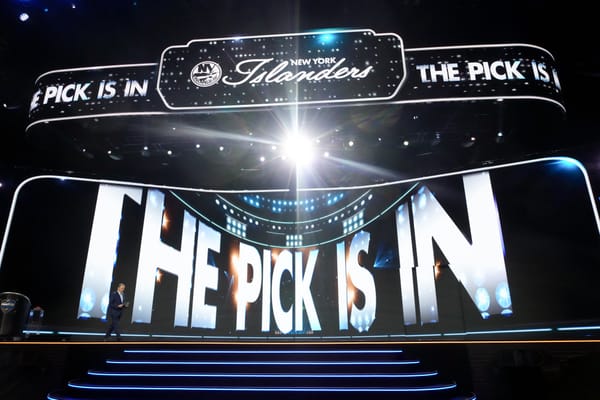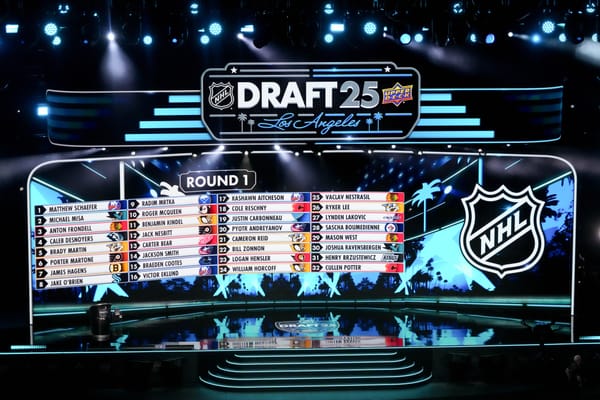Breaking Down McDonagh's OT Winner
The Rangers' season continues, thanks to Ryan McDonagh's overtime winner. Let's breakdown all the components of that play to see how the Rangers were finally able to beat Holtby and the Capitals' defensive system.
What a game! For the first 58 minutes it seemed like the Rangers' season was going to end in a frustrating shutout. But it didn't! Kreider tied it up with 101 seconds left in the game to finally break Holtby. Then, about 10 minutes into overtime, Ryan McDonagh completed the comeback with his goal.
What's so great about the overtime winner, aside from the obvious point of extending the season, is how seamlessly everything that needed to happen for the puck to go in was executed. It was a perfect example of how to put a puck past Braden Holtby and this Barry Trotz defensive system. Let's look at it piece-by-piece.
I can't say enough about this entire sequence from Jesper Fast. A lot of times the secondary assist on a goal is inconsequential and serves as nothing but a stat inflator, but in this case Fast absolutely earned his point. First, let's recognize the tremendous neutral zone play to intercept the puck. It wasn't an easy one to get his stick on, and if he doesn't then Brooks Laich is streaking down the wing with the puck. And the Rangers are in trouble.
Instead, Fast has the puck, and he only does good things with it after. He has three different Capitals converging on him, and some players might have been nervous enough about that to send the puck around the boards. Instead, Fast accepts the challenge and gains the blue line with speed before sending a great pass across the zone to a waiting Derek Stepan. Not only does this relieve the pressure and put the Rangers in a good scoring area, but it forces Braden Holtby to move laterally and puts the Capitals' defenders in a vulnerable spot.
At this point Derek Stepan has a pretty good shooting opportunity. He's at the top of the circle on his off-side, he has Holtby moving, and there's definitely a channel for the puck to reach the net if he takes a good shot. But while a number of Rangers fans were surely roaring for a shot, Stepan was smart enough to do otherwise.
Holtby, while moving, is certainly in good enough of position to make a save, and Mike Green has done a pretty good job of getting in front of Stepan and limiting his shooting lane. Instead, Stepan sells the shot and disorients the Capitals.
With Stepan faking the wrist shot, Green and Curtis Glencross do what they've been coached to do; sprawl in front of shooters. But Stepan and McDonagh beat the system. Stepan baited those two into diving in front of his potential shot. Even Holtby bit and anticipated Stepan's shot. Then Stepan makes a pass to McDonagh that is subtle but completely changes the shooting angle.
Just with that little pass, Glencross and Green are out of position, and since they left their feet there's no recovering. McDonagh intelligently takes advantage of this wide-open shooting lane and one-times the puck. Apart from giving the Capitals' skaters no time to recover, it basically handcuffs Holtby. He already shifted over to the right post when Stepan received the puck, and now Stepan's subtle pass to McDonagh did changes the trajectory of the shot yet again. Shifting back to the left immediately after just pushing to the right is not easy for a goaltender.
Combine that with Kreider getting in Holtby's line of vision. While the Rangers have gotten a lot of shots from good areas in this series, they haven't set up enough one-timers nor put bodies in front of Holtby to limit his vision. The combination of the one-timer plus the screen means that Holtby's chances of reacting to McDonagh's release in time and getting his body in a position to stop the puck are significantly reduced.
And the final people to do their job on this goal were the Hockey Gods. While the offensive effort from the Rangers needs to be better, reality is that we're probably singing a different tune about the goal scoring if pucks weren't ricocheting everywhere except into the net this series. This time, the puck hit Tim Gleason's leg and caromed into the net. If Holtby had little chance at stopping the puck before, then the redirection made it impossible.
This is a perfect example of how the Rangers need to play in order to put some pucks past Holtby and the Capitals. They need to gain the offensive zone with speed and possession. They need to send the puck across the zone to make Holtby move. They need to bait the Capitals' skaters into overcommitting to potential shots and therefore drawing them out of the play. They need to create quick shots off of feeds to reduce Holtby's reaction time. They need to get bodies in front of Holtby to reduce his vision.
But ultimately, doing all of that will be fruitless if they have absurd puck luck like they've endured most of this series. Sometimes you can do all the right things and get no reward for it, and sometimes Jay Beagle tosses a puck from behind the net and gets a ridiculous bounce off of Yandle's skate. That's just hockey. Thankfully, the Rangers had no ill fortune on the overtime winner, and their season is still alive.




